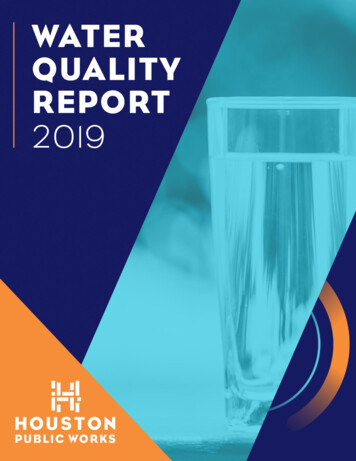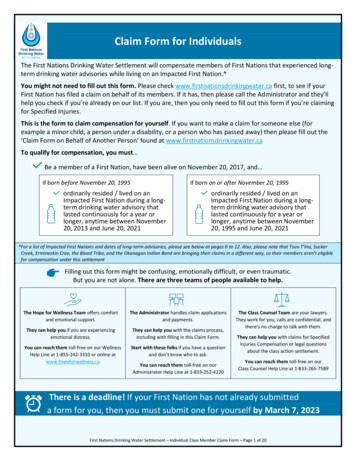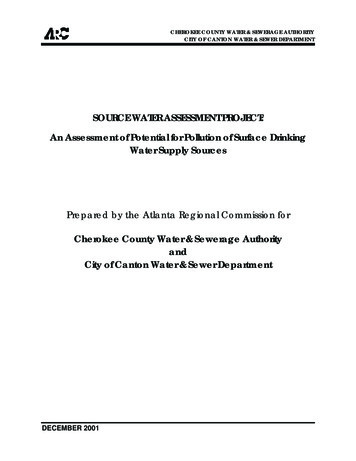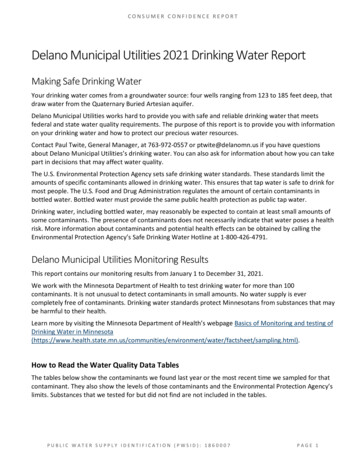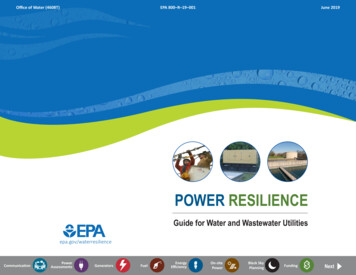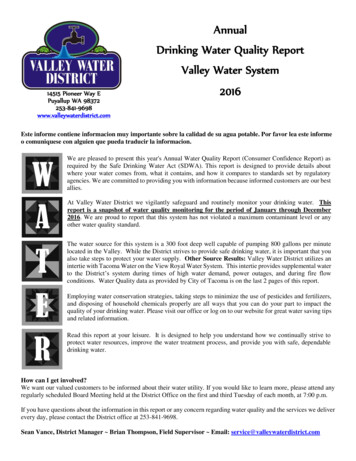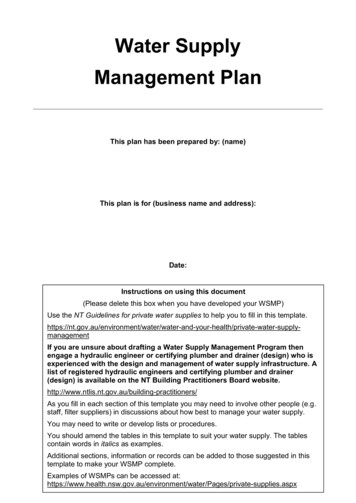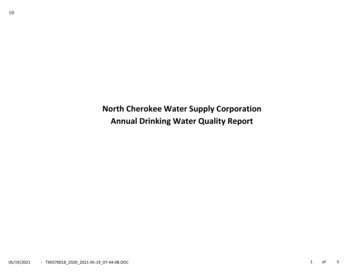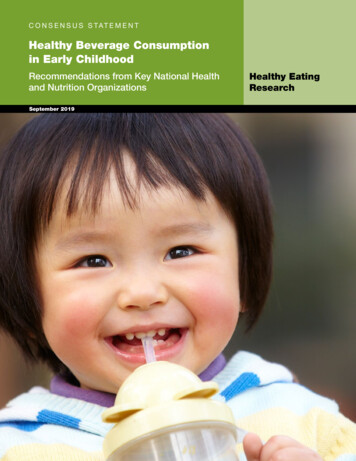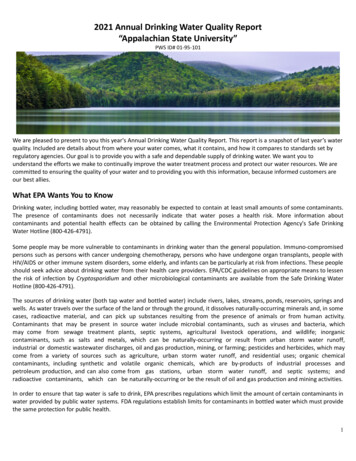
Transcription
2021 Annual Drinking Water Quality Report“Appalachian State University”PWS ID# 01-95-101We are pleased to present to you this year's Annual Drinking Water Quality Report. This report is a snapshot of last year’s waterquality. Included are details about from where your water comes, what it contains, and how it compares to standards set byregulatory agencies. Our goal is to provide you with a safe and dependable supply of drinking water. We want you tounderstand the efforts we make to continually improve the water treatment process and protect our water resources. We arecommitted to ensuring the quality of your water and to providing you with this information, because informed customers areour best allies.What EPA Wants You to KnowDrinking water, including bottled water, may reasonably be expected to contain at least small amounts of some contaminants.The presence of contaminants does not necessarily indicate that water poses a health risk. More information aboutcontaminants and potential health effects can be obtained by calling the Environmental Protection Agency's Safe DrinkingWater Hotline (800-426-4791).Some people may be more vulnerable to contaminants in drinking water than the general population. Immuno-compromisedpersons such as persons with cancer undergoing chemotherapy, persons who have undergone organ transplants, people withHIV/AIDS or other immune system disorders, some elderly, and infants can be particularly at risk from infections. These peopleshould seek advice about drinking water from their health care providers. EPA/CDC guidelines on appropriate means to lessenthe risk of infection by Cryptosporidium and other microbiological contaminants are available from the Safe Drinking WaterHotline (800-426-4791).The sources of drinking water (both tap water and bottled water) include rivers, lakes, streams, ponds, reservoirs, springs andwells. As water travels over the surface of the land or through the ground, it dissolves naturally-occurring minerals and, in somecases, radioactive material, and can pick up substances resulting from the presence of animals or from human activity.Contaminants that may be present in source water include microbial contaminants, such as viruses and bacteria, whichmay come from sewage treatment plants, septic systems, agricultural livestock operations, and wildlife; inorganiccontaminants, such as salts and metals, which can be naturally-occurring or result from urban storm water runoff,industrial or domestic wastewater discharges, oil and gas production, mining, or farming; pesticides and herbicides, which maycome from a variety of sources such as agriculture, urban storm water runoff, and residential uses; organic chemicalcontaminants, including synthetic and volatile organic chemicals, which are by-products of industrial processes andpetroleum production, and can also come from gas stations, urban storm water runoff, and septic systems; andradioactive contaminants, which can be naturally-occurring or be the result of oil and gas production and mining activities.In order to ensure that tap water is safe to drink, EPA prescribes regulations which limit the amount of certain contaminants inwater provided by public water systems. FDA regulations establish limits for contaminants in bottled water which must providethe same protection for public health.1
When You Turn on Your Tap, Consider theSourceThe Appalachian State University uses surface water for thesource of all water produced by our water system. Theprimary water source is the Norris Branch stream, which islocated off Rainbow Trail Road. This small stream is fedfrom the Howards Knob watershed. There is no industrialactivity within the Howards Knob watershed with limitedresidential development, so there is little danger fromcontaminants associated with those activities. A largereservoir stores approximately 300 million gallons of waterfrom the Howards Knob watershed. The secondary watersource, used periodically in dry conditions is Howards Creekwhich is fed from the Rich Mountain watershed.Source Water Assessment Program (SWAP)ResultsThe North Carolina Department of Environment andNatural Resources (DENR), Public Water Supply (PWS)Section, Source Water Assessment Program (SWAP) hasconducted assessments for all drinking water sourcesacross North Carolina. The purpose of the assessmentswas to determine the susceptibility of each drinking watersource (well or surface water intake) to PotentialContaminant Sources (PCSs). The results of the assessmentare available in SWAP Assessment Reports that includemaps, background information and a relative susceptibilityrating of Higher, Moderate or Lower.The relative susceptibility rating of each source forAppalachian State University was determined by combiningthe contaminant rating (number and location of PCSswithin the assessment area) and the inherent vulnerabilityrating (i.e., characteristics or existing conditions of the wellor watershed and its delineated assessment area.). Theassessment findings are summarized in the table below:Susceptibility of Sources to Potential Contaminant Sources(PCSs)Source NameNorris BranchHowards CreekSusceptibility RatingModerateModerateThe complete SWAP Assessment report for Appalachian State University may be viewed on the web at:https://www.ncwater.org/?page 600&Action Swap SearchPlease note that because SWAP results and reports are periodically updated by the PWS Section, the results available on thisweb site may differ from the results that were available at the time this CCR was prepared. To obtain a printed copy of thisreport, please mail a written request to: Source Water Assessment Program – Report Request, 1634 Mail Service Center,Raleigh NC 27699-1634, or email request to swap@ncmail.net. Please indicate your system name, PWSID, and provide yourname, mailing address and phone number. If you have any questions about the SWAP report please contact the Source WaterAssessment staff by phone at 919-715-2633. It is important to understand that a susceptibility rating of “higher" does not implypoor water quality, only the systems’ potential to become contaminated by PCS’s in the assessment area.What If I Have Any Questions Or Would Like to Become More Involved?App State’s Water System is administered through the Facility Operations Department. All operational data is stored on siteat the Water Treatment Facility on Rainbow Trail and is open for public inspection. If you have any questions about this reportor your water utility, please contact Dan Gryder, Facilities Engineer, at 828-262-8784.2
Water Quality Data Table of Detected ContaminantsWe routinely monitor for over 150 contaminants in your drinking water according to Federal and State laws. The following tablelists the drinking water contaminants that we detected in the last round of sampling for the particular contaminant group. Thepresence of contaminants does not necessarily indicate that water poses a health risk. As required by the EPA or the State,asbestos, lead and copper are monitored less than annually. These tests are not performed annually because theconcentrations of these contaminants do not vary significantly from year to year. Except as discussed above or otherwisenoted, the data presented in this table is for testing completed January 1 through December 31, 2021. Some of the data,though representative of the water quality, is more than one year old.Unregulated contaminants are those for which EPA has not established drinking water standards. The purpose of unregulatedcontaminant monitoring is to assist EPA in determining the occurrence of unregulated contaminants in drinking water andwhether future regulation is warranted.Secondary Contaminants like iron and manganese, which are required for testing by the NC Public Water Supply Section, aresubstances that affect the taste, odor, and/or color of drinking water. These aesthetic contaminants normally do not have anyhealth effects and normally do not affect the safety of your water.Contaminant(units)MCLViolationY/NYour Water(ppm)RangeLow HighAllowableLimits (AL)ReportingLevelLikely Source of ContaminationManganese(mg/L)N 0.01N/AN/A0.01Naturally OccurringIron (mg/L)N 0.06N/AN/A.06Treatment Processes / Distribution PipingRadiological AnalysisApp State is required by the NC Public Water Supply Section to perform a radiological analysis every 6 years.ContaminantMethodCodeRequired Reporting Limit(pCi/L)Gross Alpha4353Not Detected (i.e. RRL)Quantified Results(pCi/L)Allowable Limits (pCi/L) 1515Not DetectedApp State did not find any radiological test results above the maximum allowable limit. The analysis was started on09/30/19 and concluded on 10/01/19.Water CharacteristicsWater Characteristics(units)Sample DateYour WaterRange Low/HighSecondary MCLpH10/20/217.77 - 86.5 to 8.5Sodium (mg/L)10/20/215.171 - 20NAAlkalinity (mg/L)10/20/2117Low HardnessNAAlkalinity is used to measure hardness in the water. The scale commonly used is 0 – 250 mg/L, with anything greater than 200mg/L considered hard water. There are no related health concerns with Alkalinity levels.3
Lead and CopperApp State is required to test for lead and copper every three years. The results from the last required test, in 2021 are average)# of sitesabove ALMCLViolation Y/NMCLLikely Source of ContaminationCopper (ppm)(90th percentile)20210.183 ppm0NAL 1.3ppmCorrosion of plumbing systems;erosion of natural deposits; leachingfrom wood preservativesLead (ppb)(90th percentile)20212 ppb2NAL 15ppbCorrosion of household plumbingsystems, erosion of natural depositsInfants and young children are typically more vulnerable to lead in drinking water than the general population. It is possiblethat lead levels at your home may be higher than at other homes in the community as a result of materials used in your home'splumbing. If you are concerned about elevated lead levels in your home's water, you may wish to have your water tested andflush your tap for 30 seconds to 2 minutes before using tap water. Additional information is available from the Safe DrinkingWater Hotline (800-426-4791).Nitrate/Nitrite AnalysisApp State is required to test for Nitrate and Nitrite Nitrogen every year.Contaminant(units)SampleDateYour WaterQuantifiedResultsReporting LimitMCLViolation Y/NMCLLikely Source of ContaminationNitrate Nitrogen(mg/L)10/13/20 11N10Animal waste in watershed runoffNitrite Nitrogen(mg/L)10/13/20 0.10.1N1Animal waste in watershed runoffInfants and young children who are exposed to high levels of Nitrate and/or Nitrite in their drinking water can develop lifethreatening health problems. Nitrates and Nitrites usually contaminate drinking water from run off contaminated by animalwaste, over fertilization, and waste management site seepage.Disinfection Byproduct Precursors ContaminantsContaminant (units)Total Organic Carbon WaterRangeLow - HighMCLGMCLLikely Source of ContaminationQuarterlyN 11.0 to 1.1N/ATTNaturally present in theenvironmentNote: Depending on the TOC in our source water, the system MUST have a certain % removal of TOC or must achievealternative compliance criteria. If we do not achieve that % removal, there is an alternative % removal. If we fail to meet thealternative % removal, we are in violation of a Treatment Technique. App State's water system used Alternative ComplianceCriteria 2 as the method to comply with the disinfectants/disinfectant byproducts treatment technique requirements.The App State TOC testing results were generally below the required reporting level of 1.0 mg/L. No test results were abovethe maximum contaminant level.4
Disinfectants and Disinfection Byproducts ContaminantsDisinfectionByproduct(parts per billion)TTHM (ppb)[Total Trihalomethanes]HAA5 (ppb)[Total Haloacetic A)N8033.248N6038.954Current(OEL)Likely Source ofContamination25 - 6336.5By-product of drinkingwater disinfection40 - 6032By-product of drinkingwater disinfectionRangeLowHighDisinfection byproducts (DBPs) are chemicals that form, during drinking water treatment and distribution, when naturallyoccurring organic matter reacts with chlorine or other disinfectants used to kill pathogenic organisms. The EPA has determinedthat four of these chemicals, or classes of chemicals, pose potential health risks and must be regulated. DBP’s are also morelikely to form as water age in the supply pipes and tanks increases, like between semesters when water use drops dramatically.Facility Operations flushes the distribution system when water usage is lowest to minimize the formation of DBP’s. We havealso made additional adjustments in production and pumping to cycle water storage to minimize the water age.Public NoticesWhen the water plant has a reporting violation, a notice must be supplied to the public. Attachment A on page seven of thisdocument details a reporting violation from June 2021. The total coliform routine sample was not submitted to the state ontime. The samples were required to be submitted to the state by July 10, 2021. The state did not receive the samples until July12, 2021.At no point was the quality of the App State's drinking water compromised, and public health was not impacted. The AppState water treatment plant staff have taken corrective actions to ensure that routine sample analysis reporting will not bedelayed again in the future.5
Important Drinking Water Definitions:Action Level (AL) - The concentration of a contaminantwhich, if exceeded, triggers treatment or otherrequirements which a water system must follow.Maximum Contaminant Level (MCL) - The highest level of acontaminant that is allowed in drinking water. MCLs are setas close to the MCLGs as feasible using the best availabletreatment technology.Nephelometric Turbidity Unit (NTU) - Nephelometricturbidity unit is a measure of the clarity of water. Turbidityin excess of 5 NTU is just noticeable to the average person.Treatment Technique (TT) - A treatment technique is arequired process intended to reduce the level of acontaminant in drinking water.Maximum Contaminant Level Goal (MRLG) – The level of acontaminant in drinking water below which there is noknown or expected risk to health. MCLG’s allow for amargin of safety.Not-Applicable (N/A) – Information not applicable/notrequired for that particular water system or for thatparticular rule.Parts per million (ppm) or Milligrams per liter (mg/L) One part per million corresponds to one minute in twoyears or a single penny in 10,000.Non-Detects (ND) - Laboratory analysis indicates that thecontaminant is not present at the level of detection set forthe particular methodology used.Parts per billion (ppb) or Micrograms per liter (ug/L) - Onepart per billion corresponds to one minute in 2,000 years,or a single penny in 10,000,000.Locational Running Annual Average (LRAA) – A runningaverage of the last four quarters.Parts per trillion (ppt) or Nanograms per liter(nanograms/L) - One part per trillion corresponds to oneminute in 2,000,000 years, or a single penny in 10,000,000,000.Picocuries per liter (pCi/L) - Picocuries per liter is ameasure of the radioactivity in water.Million Fibers per Liter (MFL) - Million fibers per liter is ameasure of the presence of asbestos fibers that are longerthan 10 micrometers.Operation Evaluation Level (OEL) – A weighted average ofthe last three quarters with the most recent quarterreceiving double weighting.Extra Note: MCLs are set at very stringent levels. To understandthe possible health effects described for many regulatedconstituents, a person would have to drink 2 liters of water everyday at the MCL level for a lifetime to have a one-in-a-millionchance of having the described health effect.For more information, please contact:Responsible PersonSystem NameSystem Address (Street)Dan GryderAppalachian State Univ WTP265 Dale StreetPhone NumberSystem PWSID #System Address (City, State, Zip)(828) 262-8784NC 01-95-101Boone, NC 286086
1NOTICE TO THE PUBLIC - Reporting ViolationIMPORTANT INFORMATION ABOUT YOUR DRINKING WATERReporting Requirement(s) Not Met for APPALACHIAN STATE UNIV WTPWe are required to report the results of monitoring of your drinking water for specific contaminants on a regular basis.Results of regular monitoring are an indicator of whether or not your drinking water meets health standards. During theMonthly compliance period beginning June 1, 2021, we did not report the results of monitoring for total coliform (routinesample} within the required timeframe.Our system failed to notify the state drinking water program as required by July 10, 2021. These reports weresubmitted on July 12, 2021. Although public health was not impacted, as our customers, you have a right to knowwhat happened and what we did to correct the situation.What should I do?There is nothing you need to do at this time. You do not need to boil your water or take other actions.What is being done?While we did not notify the state as quickly as we should have, we have developed standard operating procedures toprevent this error from happening again. These new procedures became effective on December 21, 2021. We are nolonger in violation.Please share this information with all the other people who drink this water, especially those ho may not havereceived this notice directly (for example, people in apartments, nursing homes, schools and usinesses). Youcan do this by posting this notice in a public place or distributing copies by hand or mail.For more ·im ormat,on, Please contact:Responsible PersonSystem NameJ{PtryJoJl (tO,'APPALACHIAN STATE UNIV WTPSystem NumberPhone Number?2r i Z.-1'l1?Notice of Violation Date:System Address (Street}j &, P,11. ISystem Address (City, State, Zip)fsoor NC0195101I (.,2.Rt,IJf'August 06, 2021Date Notice Distributed: Week of March 14, 2022 Method of Dis tribution: Consumer Confidence ReportPublic Notification Certification:The public water system named above hereby affirms that public notification has been provided to its consumer inaccordance with all delivery, content, format, and deadline requirements specified in 15A NCAC 18C .1523.Owner/Operator:p -(Signature)T"(,t/r'/r.Jl/'fo (Print Name)? l-2 22(Date)
"Appalachian State University" PWS ID# 01-95-101 We are pleased to present to you this year's Annual Drinking Water Quality Report. This report is a snapshot of last year's water quality. Included are details about from where your water comes, what it contains, and how it compares to standards set by regulatory agencies.
